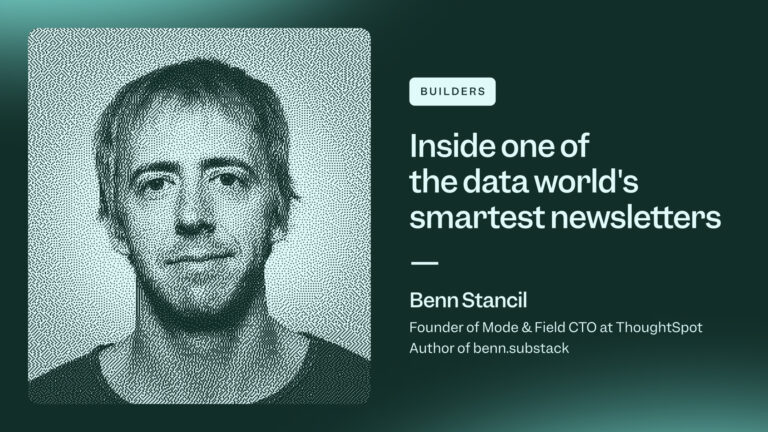The Zen of Tomasz Tunguz

Whoever can see through all fear
will always be safe.
– Tao Te Ching
A whisper in a Manhattan barroom, an idle conversation at a Palo Alto coffee shop, and rumor mills start to churn.
The internet streamlines and aggregates this gossip and soon, before it should be possible, markets are dipping and someone halfway around the world is panicking, and the panic builds until companies are shedding value and employees.
The antidote to all of this gossip and speculation is, as it should be, data. That’s what gets Tomasz Tunguz up before everyone else in the Valley. It’s why everyone from entrepreneurs to investors flock to his blog. His data-driven insights and metrics offer sanity and clarity on the state of tech, and of SaaS in particular, and cut through the panic. But that doesn’t mean his chart-filled posts don’t also have a quietly beating heart to them as well.
“The way people use data is emotionally-driven,” says one of the most data-driven VCs in the Valley. Let that sink in for a moment.
Tomasz doesn’t think that emotions are bad – in fact, they are the guiding force for making a choice, after weighing all the information available. But the information is all there, if you care to look for it. And Tomasz does.
On his blockbuster blog and throughout his career, Tomasz has been moderating a discussion between two equal but opposite forces. On the one side lie emotions, instincts, and those hunches that prompt you to say “I believe.” On the other side are data-backed, numbers-crunching insights, gleaned from the rote work of poring through CSVs and databases.
The goal of this moderation? To help founders make products and companies that work well. The information necessary to do that has never been so abundant or omnipresent, and it can ground otherwise emotional decisions. All one has to do is go with the flow of data.
But immersing yourself in data isn’t sexy. And it demands the question: Is it really that simple?
It is. But you’ve got to know what to do with it all.
Measure twice, cut once
It’s no secret that Q4 2015 and Q1 2016 were rough on tech and overall, with speculation pushing the news cycle into a frenetic tailspin.
If you’re reading TechCrunch or The Wall Street Journal on a particular day, then things are looking up. Or you can choose USA Today and Quartz for a more pessimistic outlook. Mattermark probably has it best: it’s both awesome and awful (although the sky isn’t falling), and Bloomberg is trying to figure it all out. But at the Redpoint Ventures office in SOMA, you wouldn’t know there was such a hullabaloo outside its walls.
It’s as quiet as a library during final exams when we meet Tomasz; the rest of the Redpoint team is packed into their Menlo Park location. Later in the week, the team will be back to fill up the SOMA digs. “You can barely hear yourself think in here then,” he says as we walk past a lone data scientist who, like Tomasz, is enjoying the quiet of the airy, sunlit open space. Tom (as he introduced himself) leads us to a conference room and draws the blinds so as not to distract the data scientist.
Given his importance to the unofficial online VC think tank, it’s strange to think that venture capital wasn’t one of his career goals.
“I studied engineering in school, and I worked a lot in the machine shop and the wood shop, and built lots of things,” he tells us. “Then, as a computer programmer, I built software. The next step was, how do you build a company?”
When he was just 17, Tom co-founded a company with his father that built billing and document management software for law firms. After graduating from Dartmouth with degrees in mechanical engineering and machine learning (and a masters in engineering management for good measure), he went to work for another tech company in Washington D.C., building software for the Department of Homeland Security. It wasn’t long before he applied to Google, looking for a product management role. There was just one problem.
“My GPA was 3.3, so they wouldn’t take me as a product manager. I worked in sales,” he says with a chuckle. He rose quickly at Google, though, eventually becoming the product manager for AdSense. But for someone with an entrepreneurial and engineering mindset like Tom, circling back to company creation seemed like the natural next step from the prestige of a product manager role at Google.
“The leap to venture was a little bit accidental. But I was always looking around the corner at what could come next.”
“VCs have a front row seat into company creation and company formation,” he continues. “In order to be a VC, you have to be passionate about company creation.”
“Another way of thinking about VC is, you can have a lot of different hypotheses about how the world is going to evolve, and every once in awhile, you make a bet. And so, there’s a part of it that’s almost academic in that sense.” To paraphrase David McRaney, the things you do often create the things you believe. To invent future markets, then, one must first believe in the people or companies that are already doing.
“For instance, voice recognition technology is really advancing. What is that world gonna look like in five years? Let me make an investment. Let me make a bet to see what the consequence to that might be. We’ll find a company to shape the future in that direction.”
And that’s where his blog, TomTunguz.com, finds itself: an ongoing discussion between instinct and data. It is here that Tom presents his tech industry analysis and insider insights, on a daily basis doing the unglamorous data dissection that helps shape a data-driven future.
Growing from 15 pageviews a month to over 100,000, Tom somehow always stays one step ahead of the news cycle, doing the satisfying work of presenting data on everything from the future of chatbots to what a typical billion dollar startup acquisition looks like to esoteric concepts like “innovating at the intersection of fields.”
Talking to Tom, it’s obvious that he delights in making the intangible tangible, the invisible visible, and the counters accountable.
As to why Tom blogs at all, that, too, began accidentally. Awake in the small hours of the morning with his newborn son, he found himself with unexpected time to ruminate.
“Founders were asking questions at board meetings that I didn’t know the answers to. But it seemed like we, as a board, ought to have had answers to questions like, ‘How fast should we be growing? What does a typical seed round look like? How much money should we raise? Or, if I raise a little bit more in my seed round, does that increase the odds of me raising a Series A?’”
“And so, we’d do the analysis once, and then I would share it with the founder, but none of it was proprietary, so… may as well publish it! And that’s how the blog got started.”
His son is older and has a brother now (a baby girl is on the way), but Tom keeps his 4:45am alarm, and he publishes a post (nearly) every day. In a time of widespread cynicism and intermittent anxiety, Tom’s blog is a sort of virtual harbor in the storm. But that doesn’t stop people from wondering whether the storm is over, or if this is the eye in the middle of a bigger hurricane.
No one steps in the same river twice
Silicon Valley valuation corrections have a hushed, strained overtone to them. Emotions aren’t high, exactly, but emotions have taken the reins from data more than they usually do.
Fast growth covers for a multitude of sins, and that’s where venture capital has concentrated of late – to the detriment of well-heeled startups looking to make their initial public offering. Valuations fell through the floor, real money vanished, unicorns trembled, and there was not a single tech IPO in Q1 2016 (good news, though, the first one made it before May). Volatile days, indeed.
The volatility of the SaaS sector in particular has been an ongoing a focal point of Tom’s blog, occupying his thoughts across many posts. With stalwarts like Dropbox sloughing off 20% of their value, and Zenefits and MongoDB losing nearly 50% each by the end of Q4, high tech anxiety has been amplified. But it was LinkedIn losing 43% of its valuation in February that turned things up to 11.
But while the whole Valley may be skittish, Tom simply looks at the numbers.
“There’s been a little bit of an aberration, and that happens,” he says, smiling. “I don’t think it’s that big of a deal. VCs invest in companies for seven to ten years, so if the VC window closes for a quarter or two, we just wait. If we saw the number of Series B or Series C investments falling by 50%, I’d be worried.”
And if those Series B and Series C investments dropped? “What would end up happening is this: when you invest in the Series A, you’d have to think differently about the way that you’re going to invest in that company. Either you’re going to give them more money initially, so they can get to a bigger milestone to raise a bigger round, or you’re going to invest the same amount, but reserve a certain number of dollars to make sure that if the company needs money, you’re there to supply it.”
“Because the worst thing that can happen is you have a company that’s working, but it runs out of cash, and so it has to go out of business. That’s the worst thing,” he says, and laughs in a way that’s… reassuring? That seems strange to write, but this is a strange time in tech.
Yin and yang
Emotion and instinct are undervalued assets in a world that, for better or worse, equates numbers with being “data-driven.”
Founders and data-driven people loathe imperfect and uncertain information, as well they should. The logic follows, then, that if it were possible to remove emotion from decision-making, maybe tech wouldn’t be experiencing this uncertainty, and maybe there would be one big investment bonanza, with soaring valuations and massive profits. Right?
“I forget his name, but there was this German guy who was struck by lightning,” Tom tells us. “And the part of his brain that creates emotions was destroyed. That was the only part of his brain that got damaged. And so, psychologists were really interested in studying this guy, because they thought he was going to be an amazing decision maker.”
“It turned out he couldn’t make a single decision! Because he never had perfect information, he could never pick the optimum anything.”
It’s the same with venture capital. “When you’re investing in seed stage companies, you don’t have perfect information either.”
“So, every investment you make is actually ultimately an emotional attachment to that business. You tell yourself, ‘I know the risks are enormous, but I believe.’ Even the data shows this.”
He’s right; neuroscience bears this out. Data and analysis are vitally important because decision-making is unavoidably emotional. There is a balance to be achieved. There is only uncertainty because people aren’t looking at the information available to them.
Take SaaS valuations, for example. “I did an analysis of SaaS companies,” Tom says, “and it turns out that the valuation of a company, the Series A, is highly uncorrelated to the revenue at the Series A. And a third of companies that raised Series As are at zero in MRR for this particular class of companies, and there is definitely a spike around about 100k in MRR. So, at the seed and Series A, it’s definitely more art than science.”
“And what I mean by ‘art’ is that it’s a balance between supply and demand. The more demand there is for investors for a particular startup’s stock, the higher the valuation of that company, right? And the inverse is also true.”
Even as an industry like SaaS fragments, Tom sees plenty of room for it to grow and touch nearly every category. Using R to analyze CrunchBase data, as Tomasz does, is often rote work, but it can reveal so much. He thinks the next big opportunity in SaaS, for instance, is through mobile. (The data is pretty clear that mobile is eating the world.)
“More than 20% of end users will login on mobile,” he says. “But we really haven’t figured out how to use mobile apps for distribution in order to get a huge customer base. Of all the different workflows and things that would work, how many would have preferred to do it on a mobile phone? Is it 50/50? Is it 70/30? I don’t know what the right answer is, but it’s definitely more than 10%.” Tom sees real estate, construction, and finance as the categories that push mobile innovations. But that’s only part of the picture.
“There’s been a big correction in SaaS valuations, but business is still growing,” he says, “and there’s no apparent slow down the buyer demand. There are certain categories, like sales and marketing technology, where there were 500 vendors two years ago, 1,000 a year ago, and around 2,500 now. That’s an over-supply problem, which is not a bad thing! A lack of demand problem is a totally a different story, because then there aren’t enough buyers for your SaaS product. Now what ends up happening is there’s just a ton of competition.”
To Tom, this is fantastic. “Startups are dragging prices down, and they’re just taking some of the pie that’s growing.”
His lack of cynicism is striking. Informed optimism like Tom’s could refine the scope for an entire industry, even as investor confidence fluctuates. “Changing behavior isn’t an easy thing to do,” Tom wrote early on in his blog. “It all starts with motivation triggered by a comparison between what I am doing and what I ought to be doing.”
It seems so self evident; just go to the data. But how many companies have built a data culture into their business? How many startups miss the boat because they don’t know how to actually use their data? The answers to these questions could fill a book. For Tom, they have.
Getting in the flow
Tom has collected so many patterns and experiences that he’s compiled his insights into a hardcover book, entitled Winning with Data, due this June.
In the book, Tom outlines how companies can use his data-driven approach to survive and thrive no matter what the financial climate may be.
Winning with Data seeks to offer a blueprint for what success can look like. “There are four parts. There’s the history of data and databases, what companies do wrong and what it looks like when that happens, what companies do right and what it looks like, and then how to get there.”
“What was most surprising to me writing the book is just how early the field of using data is,” he tells us. “We’ve been using data for a long, long time, of course, and we’ve had computers for a really long time, but we have no best practices for how to structure data teams.”
“There’s no single best practice. There’s no cookie cutter. There’s no template for these things.”
Tom believes that creating a data culture and using that as a way to optimize a business is transformative and, ultimately, how you win with data. No surprise, he believes that having a structured, nuanced concept of a data team is a critical part of any startup’s success.
“Put each person in the right place in the org, and then everybody’s happier. Because expectations are clear. It’s the emotions piece, again, right? Having a clear understanding of where the data is and not just being told, ‘Be data-driven!’” he says, laughing. “Managing expectations is really important.”
Relax
Except for the point,
the still point,
There would be no dance,
and there is only the dance.
– T.S. Eliot
“Consider LinkedIn or even Tableau’s stock falling by half… it’s not like, from one day to the next, that the business is worth half. It’s just that investors were feeling differently about the business.”
But feelings cause market crashes. The underlying fear of another tech bubble bursting or, at least, a more dramatic 2012-like correction doesn’t vanish in the face of statistics.
Not surprisingly, Tom isn’t very worried about any of that.
“I think Q1 2016 was a period where lots of investors were saying, ‘Okay, where is everything going to settle out? What does that mean for my existing portfolio? What does that mean for my new investments? Is this going to be a collapse like 2000, 2001?’” He chuckles. “It’s clearly nothing anywhere close.”
“This was a little bit of a steeper correction. But the countervailing forces VCs to prepare so much money, that it seems to be relatively stable. Like in Series A, all the data says nothing has changed. Seed investors may be more wary of changes in the Series A,” he tells us, “but the seed is different. Even with the total number falling, actual round sizes have increased.”
The major difference between the investment climate today and the investment climate around the dot-com crash? Investors today know what’s going on, he tells us. There’s so much more benchmarking going on now than there was a decade ago – even five years ago. And if nobody’s looking at the data and things feel like they’re being turned over and emptied out?
“It just happens sometimes,” he says with a smile.



